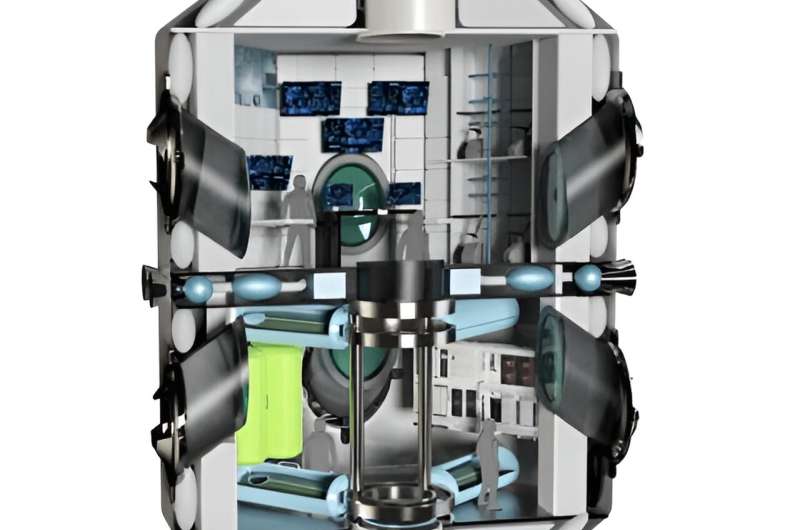This article has been reviewed according to Science X's editorial process and policies. Editors have highlighted the following attributes while ensuring the content's credibility:
fact-checked
trusted source
proofread
A detailed design for a space station at sun–Earth L2

New ideas in space exploration come from all corners, and, by and large, the community welcomes anybody interested in the field. Having just read "A City on Mars," it seems that even people who disagree with the idea that the age of space settlement is imminent will be accepted into the fold by enthusiasts. Now, a new entrant has joined—Daniel Akinwumi is a Nigerian graduate student at the University of Strathclyde who recently posted his master's thesis to ResearchGate detailing the design of the "intergalactic hub," or I-HUB.
The introductory section of the thesis lays out many of the challenges familiar to those interested in space habitats. These include the importance of robots, a completely closed-loop recycling system, and novel radiation shielding. Mr. Akinwumi also provides a thorough literature search and mentions several other design concepts similar to the I-HUB.
One crucial design choice is how to get the system into space. As of the time of writing, I-HUB will use Starship, the largest rocket ever developed, which is still being tested. Many of the other selected systems for the I-HUB would utilize technologies developed elsewhere, such as NASA's ECLSS life support system or standard RTGs for a power source.
Food is essential for any long-term habitat, and the paper looks closely at different food-production systems for use in space. NASA's Vegetable Production System is one of the most highly developed and could be used on the I-HUB with little modification. Propulsion is another key system, with I-HUB being designed behind an extensive solar electric propulsion system that would allow it to research its deep-space destination of the Earth/Sun L2 point.
Ideally, the system would be built in order, but plenty of work on robotic assemblers must take place before that will be a possibility. Any such assembly would also have to occur near Earth, as sending an army of assemblers to the L2 point would be prohibitively expensive. But the views from L2 would be spectacular, as the paper points out the site could be a helpful platform for scientific inquiry—it already houses several large-scale telescopes, including Euclid.
Once installed, the intent of I-HUB isn't to remain static but to continue to grow by adding additional modules over time to increase both its physical and operational capacity. Modular designs of the modules that would connect would be critical to this feature and would be similar to how the different modules connect on the ISS.
Some of the modules might even rotate to decrease microgravity's harmful effects on the long-term health of I-HUB's residents. It will also have an integrated communication system and, as mentioned above, a closed-looped resource recycling/life support system.
Mr. Akinwumi also detailed budgets for various systems, such as power and mass, and the expected overall cost of the station. In his analysis, he fleshed out some of the inherent risks in the system and detailed how they could be mitigated with future development work. Some of these would include multiple redundancies of the life-support systems and various layers of radiation shielding.
Overall, the plan for I-HUB seems reasonable and weighs in at a hefty 71 pages—probably a little above average for an MS thesis. However, those pages have few new ideation details; it's more a collection of ideas already detailed in other resources and in much more detail than even this thesis would allow. It's a good start on a promising research line, and hopefully, Mr. Akinwumi will continue with his Ph.D. and can delve further into the details of his I-HUB idea.
More information: Daniel Akinwumi, Design and Analysis of the Technical Infrastructure for a Self-Sufficient and Sustainable Intergalactic Hub (2023). DOI: 10.13140/rg.2.2.31707.54568
Provided by Universe Today





















